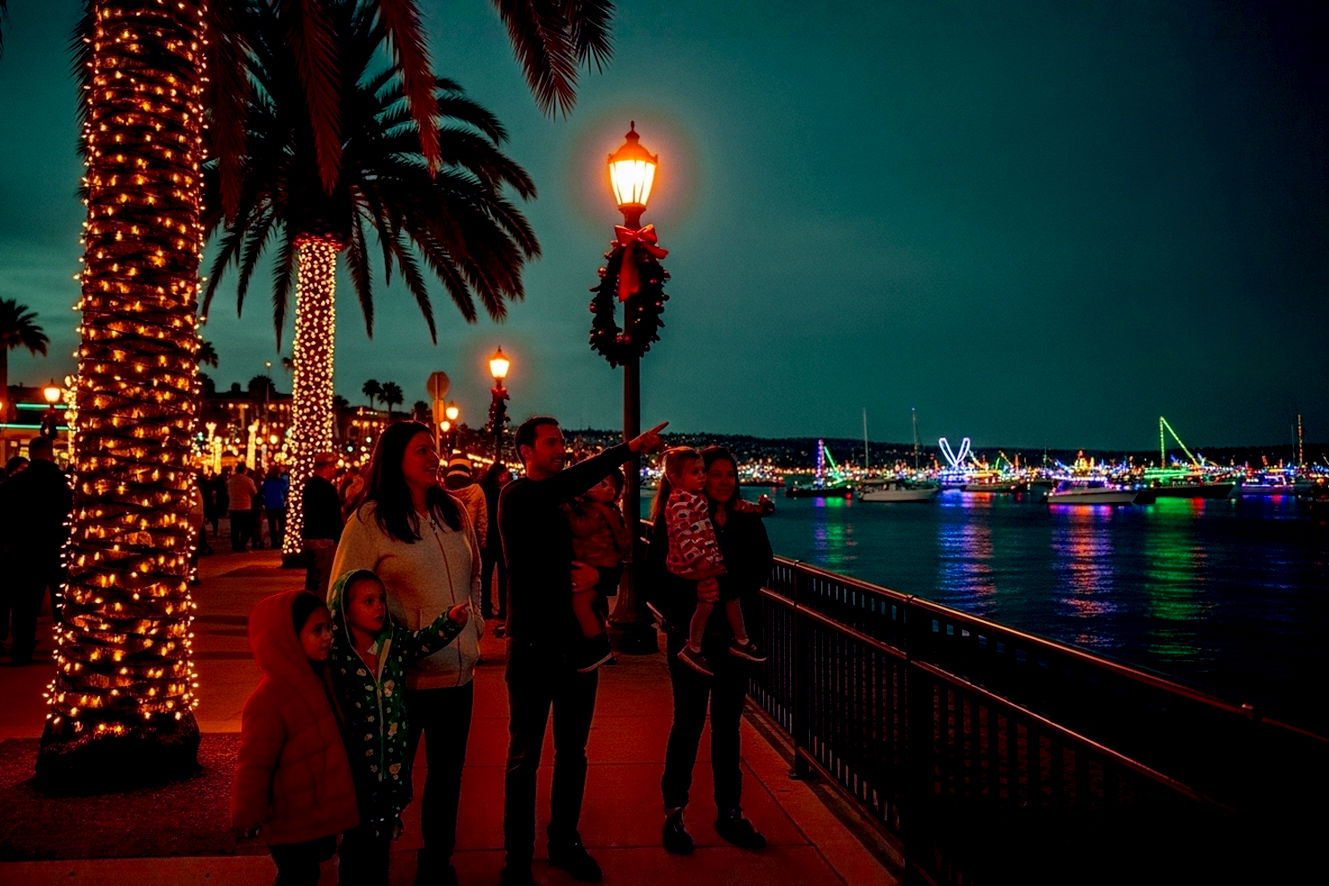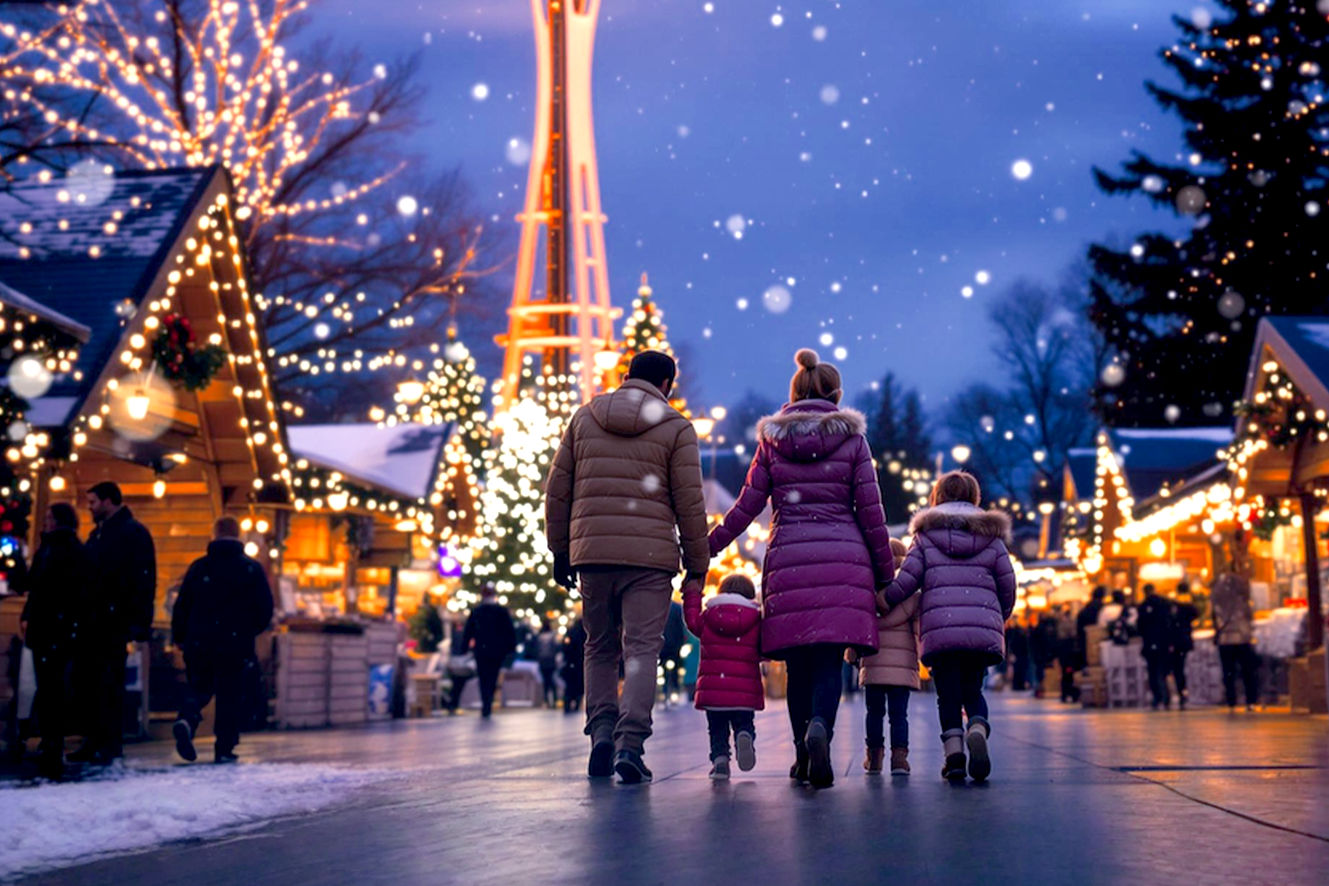This post may contain affiliate links. If you make a purchase through these links, we may earn a commission at no additional cost to you.
The holiday season in Salt Lake City, Utah, is a truly special time. The city transforms into a winter wonderland, with millions of twinkling lights creating a magical atmosphere. From massive, professional light shows to charming neighborhood displays, there’s a spectacle for everyone to enjoy. Whether you’re looking for a romantic walk, a fun family outing, or a cozy drive, you won’t be disappointed.
This comprehensive guide will walk you through the most stunning Christmas light attractions in Salt Lake City and the surrounding area. We’ll cover everything you need to know, including what makes each location unique, typical hours of operation, ticket prices, and helpful tips to make your visit go smoothly. Get ready to bundle up, grab some hot cocoa, and explore the dazzling holiday spirit of the Wasatch Front.
Downtown Delights: A Walk Through the City’s Core
Salt Lake City’s downtown area becomes the heart of the holiday celebration, with several key locations lighting up to create a festive urban landscape. These destinations are often within walking distance of each other, making them perfect for a full evening of exploration. The energy here is vibrant, with thousands of people enjoying the lights, music, and seasonal festivities. You’ll find a blend of historic grandeur and modern flair, all decked out for the holidays.
Temple Square Christmas Lights: A Timeless Tradition
The lights at Temple Square are perhaps the most famous and beloved Christmas tradition in all of Utah. For decades, families have flocked to see the grounds of The Church of Jesus Christ of Latter-day Saints headquarters lit with a stunning display. Though the Salt Lake Temple itself is currently under a multi-year renovation, the surrounding grounds still offer a spectacular show. Don’t let the construction deter you; the organizers have done an amazing job of adapting and ensuring the spirit of the season remains bright.
This massive display involves more than one million lights. Each tree, shrub, and archway is carefully wrapped in lights, creating a breathtaking, immersive experience. The display is a beautiful spectacle of classic incandescent bulbs and modern LED technology. While older incandescent lights produce a warm, nostalgic glow, modern LEDs offer a crisp, bright light while using significantly less electricity. The combination of these two technologies gives the display its distinctive look. This isn’t just about the lights, though; it’s a full experience. You’ll often find nativity scenes, musical performances, and other free events taking place throughout the month of December.
Logistics and Tips for Your Visit
- When to Visit: The lights typically turn on the day after U.S. Thanksgiving and remain on through January 1st.
- Timing: The lights usually glow from dusk until about 10:00 p.m., then again in the early morning hours. Going on a weeknight is usually a great idea, as it’s far less crowded than the weekend.
- Cost: The Temple Square Christmas lights are absolutely free to view.
- Parking: Finding parking downtown can be a challenge. Consider using public transportation like the TRAX light rail, which has a stop right at Temple Square. If you do drive, parking garages at City Creek Center or The Gateway are good options, though they may charge a fee. Be prepared to walk a bit.
- Attire: Dress warmly! Since this is a walking tour and you’ll be outside for an extended period, you’ll want to wear layers, a hat, and gloves.
Gallivan Center: Skate and Stroll in the City
Just a short walk from Temple Square, the Gallivan Center offers a different kind of holiday cheer. The central plaza features a large outdoor ice skating rink surrounded by thousands of lights. It’s a fantastic spot for a fun, active evening. You can glide across the ice under a canopy of twinkling bulbs and then warm up with a hot drink from a nearby cafe. The atmosphere is always lively and festive.
The Gallivan Center’s lights are integrated into the urban park’s architecture and landscape. Strings of lights are often draped from trees and poles, creating an inviting, open-air ballroom effect. The ice rink’s lighting system uses a variety of colors and patterns that change and shift throughout the night, adding to the dynamic ambiance. It’s a great example of how public spaces can be transformed with lighting design to encourage community gatherings during the winter months.
Logistics and Tips for Your Visit
- When to Visit: The lights and skating rink usually open in late November and stay open through early March.
- Timing: The rink has specific operating hours, so it’s a good idea to check their website before you go. It can get very busy on weekend evenings.
- Cost: Viewing the lights is free, but there is a fee for ice skating and skate rentals.
- Parking: The Gallivan Center has its own parking garage, but space can be limited. The nearby TRAX station is a very convenient alternative.
- Attire: Layer up, especially if you plan to skate. You’ll want to stay warm but also have the freedom to move around on the ice.
The Gateway: Modern Lights and Holiday Events
The Gateway is an open-air shopping and entertainment destination in downtown Salt Lake City. During the holiday season, it becomes a hub of activity with its own beautiful light display. The center’s streets and plazas are adorned with festive decorations, including a massive Christmas tree that serves as a focal point. You’ll find a more modern, commercial lighting design here, with clean lines and bright, crisp LEDs. It’s a great place to do some holiday shopping, grab a bite to eat, or just enjoy the atmosphere.
The lighting at The Gateway often features a more curated aesthetic, often integrating lighting elements into the architecture itself. For example, some displays might use low-voltage LED tape lights to outline buildings and storefronts, creating a sleek, contemporary look. The central Christmas tree often uses programmable LED strings, allowing for a variety of colors and light patterns to be displayed throughout the night. This sophisticated use of technology creates an elegant and eye-catching holiday experience.
Logistics and Tips for Your Visit
- When to Visit: The lights are typically on from mid-November through early January.
- Timing: The lights are usually on during business hours and remain on until late in the evening.
- Cost: It’s free to walk around and see the lights.
- Parking: There are several parking garages at The Gateway. They typically charge for parking, but some businesses may offer validation.
Spectacular Paid Attractions: The Ultimate Holiday Experience
For those who want a truly immersive and professionally-designed light show, Salt Lake City and its surrounding areas offer several spectacular paid attractions. These aren’t just displays; they’re full-fledged productions that use advanced lighting technology, sound, and animation to create unforgettable memories. These are often destinations in themselves, providing a full evening of entertainment.
ZooLights at Utah’s Hogle Zoo: Where the Wild Things Glow
ZooLights is an annual tradition at Utah’s Hogle Zoo. It’s a unique experience that combines a classic light display with the charm of a zoo after dark. While most of the animals are sleeping, the zoo grounds come alive with hundreds of animated light displays that feature animal and holiday scenes. You’ll walk along paths illuminated by glowing giraffes, elephants, and other creatures. One of the main highlights is the impressive 135-foot light tunnel, which provides a dazzling, multi-sensory experience as you pass through.
The technology behind ZooLights is a great example of how lighting can be used for storytelling. Many of the displays are static sculptures made of steel frames and wrapped in LED light strings, but a key element is the animated displays. These use specialized control systems, often with DMX controllers, to sequence the lights. This allows for a precise timing of color changes, fades, and strobing effects, making a seemingly static animal display appear to be moving or interacting with its environment. The combination of music and carefully choreographed lights creates a sense of wonder that’s perfect for all ages.
Logistics and Tips for Your Visit
- When to Visit: ZooLights runs on select nights from late November through early January. It’s important to check their calendar for specific dates and times.
- Timing: The event is an after-hours experience, so it starts after the regular zoo closes. Most nights it runs from 5:30 p.m. to 9:00 p.m.
- Cost: ZooLights is a separate ticketed event and isn’t included with regular daytime zoo admission. Tickets must be purchased in advance online for a specific date and time. Hogle Zoo members often receive a discount.
- Attire: This is a walk-through event, and Utah winters can be very cold. Wear warm layers, boots, hats, and gloves. You’ll want to be comfortable while you explore.
- Accessibility: Most paths are paved and accessible for strollers and wheelchairs, but it’s always a good idea to check their website for the most current information.
Christmas in Color: A Drive-Thru Spectacle
For those who want to stay warm and cozy in their car, Christmas in Color is the perfect choice. This drive-through light show, located in South Jordan, features over one million lights synchronized to holiday music. You tune your car radio to a specific FM station, and as you drive along the mile-long route, the lights dance and flash in perfect rhythm with the songs. It’s a completely immersive experience that you can enjoy from the comfort of your own vehicle.
The technology that makes this show possible is called light sequencing. This is a process where lights are carefully programmed to turn on, off, and change color in time with an audio track. The programming is incredibly detailed, often done frame-by-frame. The lights themselves are typically energy-efficient LEDs, which can be individually addressed and controlled, allowing for complex and fast-paced patterns. The use of a low-power FM transmitter allows the audio to be broadcast directly to your car, perfectly syncing the music to the visual show. The entire setup is a marvel of both creative design and technical engineering.
Logistics and Tips for Your Visit
- When to Visit: The event usually starts a bit earlier than other attractions, often in mid-November, and runs through the first week of January.
- Timing: Operating hours are typically from 5:30 p.m. to 10:00 p.m. Weeknights are generally less crowded and can have shorter wait times.
- Cost: Tickets are sold per car, not per person. Prices can vary depending on the day of the week and if you buy them in advance.
- Planning: Be sure to buy your tickets online beforehand, as they are often required for entry and can sell out. This is especially true for popular weekend slots.
- The Experience: Keep your windows down for a better audio-visual experience, but be sure to have the heat on!
Luminaria at Thanksgiving Point: A Garden of Light
A short drive south of Salt Lake City in Lehi, you’ll find Luminaria, a breathtaking walk-through experience at Thanksgiving Point’s Ashton Gardens. This event transforms the 50-acre gardens into a stunning display of over a million lights. The theme changes each year, but it always features impressive large-scale light installations, a light tunnel, and a “light of the world” sculpture on the hill that changes colors. This is a highly visual and aesthetic experience that is both beautiful and peaceful.
The lighting at Luminaria is incredibly sophisticated. It’s a great example of how lighting can be used for large-scale art and landscape design. Many of the installations use programmable RGB LED fixtures, which can produce millions of colors. These fixtures are controlled by a central show-control system that allows for complex, synchronized light shows that cover entire sections of the garden. The “light of the world” sculpture, for example, is likely a large-scale matrix of lights, where each light can be controlled individually to create dynamic patterns and imagery across the surface. This type of technical orchestration is what makes the experience so memorable.
Logistics and Tips for Your Visit
- When to Visit: Luminaria runs from late November through early January.
- Timing: The gardens are open nightly during the event. It’s a good idea to get there right when it opens to avoid the biggest crowds.
- Cost: Tickets are required and must be purchased online in advance. They are sold for specific entry times.
- Attire: This is a walk-through event on a massive scale, so wear comfortable walking shoes and dress for the cold.
- The Experience: The walk can take a couple of hours, so plan accordingly. There are often food vendors and fire pits to help you warm up along the way.
Quaint and Charming Local Spots: Neighborhood and Community Gems
Sometimes the best holiday lights aren’t the big, commercial spectacles. Salt Lake City has a variety of smaller, more intimate displays that offer a unique, community-focused experience. These spots often rely on the collective effort of residents or local businesses to create a charming, festive atmosphere.
Gardner Village: Whimsical Elves and Historic Charm
Located in West Jordan, Gardner Village is a historic landmark that comes alive during the holidays. The village’s quaint shops and walkways are adorned with thousands of twinkling lights. The main draw, however, is the scavenger hunt for dozens of whimsical elves that are hidden throughout the grounds. It’s a festive and engaging activity that’s perfect for families. The lights here are designed to complement the historic buildings, with classic C7 and C9 bulbs creating a warm, vintage glow.
Gardner Village’s lighting design often uses a combination of classic and modern techniques to create its rustic feel. The large, old-fashioned C7 and C9 bulbs, which use traditional incandescent filaments, provide a specific nostalgic warmth and are a hallmark of classic holiday lighting. These are complemented by LED rope lights that outline buildings and pathways, providing a more reliable and energy-efficient solution. This blend of styles helps maintain the village’s historic charm while ensuring a bright and inviting display.
Logistics and Tips for Your Visit
- When to Visit: The decorations and elf displays are typically up from mid-November through the end of December.
- Timing: The lights are on from dusk until the shops close. You can still walk around the village after hours to see the lights, though the stores will be closed.
- Cost: Walking through the village and seeing the lights is free. There is no charge for the elf scavenger hunt.
- Parking: Parking can be challenging on busy nights, so try to go on a weeknight.
Draper Tree of Life: A Free and Breathtaking Display
In Draper City Park, a massive ancient tree is wrapped with millions of lights, creating a truly spectacular sight known as the Tree of Life. This free display is a popular destination, and it’s easy to see why. The sheer number of lights on a single, giant tree is awe-inspiring. Visitors can walk right underneath the canopy of lights, which creates a mesmerizing, immersive effect. The rest of the park is also decorated, making for a pleasant and free evening stroll.
The lighting of the Tree of Life is a technical feat. The process involves wrapping a huge number of light strings around every branch and trunk of the tree. This often requires a dedicated team of installers working with lifts and specialized equipment. The lights used are typically commercial-grade LED strings, which are more durable and brighter than consumer-grade lights. The electrical load is a significant consideration, requiring a robust power distribution system to handle the massive number of lights without tripping circuit breakers. The result is a breathtaking, almost blindingly bright display that can be seen from a distance.
Logistics and Tips for Your Visit
- When to Visit: The Tree of Life is usually lit up from late November through early January.
- Timing: The lights are on from dusk until late at night.
- Cost: This is a free attraction.
- Parking: Parking is available at Draper City Park, but it fills up very quickly on weekends.
Spanish Fork Festival of Lights: A Southern Utah County Favorite
Just a bit south of Salt Lake City, the Spanish Fork Festival of Lights is one of Utah’s largest drive-through holiday displays. Held in Canyon View Park, the route takes you on a festive journey through hundreds of animated light displays. It’s a wonderful option for those who want a longer, less crowded driving experience than some of the neighborhood displays. You’ll see everything from classic holiday scenes to fun, whimsical characters, all made of light.
Like Christmas in Color, the Spanish Fork Festival of Lights uses a combination of light sculptures and animation. The majority of the displays are static wireframes covered in lights, but many include moving parts that are controlled by simple motors or relays. This creates the illusion of movement, with reindeer leaping or snowmen waving. The entire route is designed to be a continuous experience, with each scene flowing into the next, and the scale of the park allows for a much grander and more spread-out display.
Logistics and Tips for Your Visit
- When to Visit: The festival typically runs from Thanksgiving night through New Year’s Day.
- Timing: The hours are usually from 6:00 p.m. to 10:00 p.m. every night.
- Cost: This is a paid event, with a per-car fee charged at the entrance.
- The Experience: Be prepared for a line of cars, especially on weekends and closer to Christmas. Pack some snacks and hot chocolate to make the wait more enjoyable.
Neighborhood Displays: The Heart and Soul of Holiday Lights
Beyond the major attractions, many Salt Lake City neighborhoods go all out, creating their own dazzling displays that are a testament to community spirit. These displays are often free and offer a more personal, charming experience. Driving or walking through a well-decorated neighborhood is a classic holiday activity that reminds you of the true meaning of the season.
Christmas Street in Sugar House
Christmas Street, also known as Glen Arbor Street, is a long-standing tradition in the Sugar House neighborhood. For generations, residents have worked together to decorate their homes with an incredible variety of lights and displays. The street becomes a destination for people from all over the valley. You’ll see everything from classic vintage decorations to modern, flashy displays, all a part of a unified, block-long celebration.
The community coordination that goes into a display like this is quite impressive. Many neighbors work together to synchronize their displays, often using simple timer boxes or even more advanced computer-controlled systems for music and animation. The lighting used is a mix of everything, from classic C9 bulbs that have been in use for decades to the latest in LED projectors and animated signs. The sheer volume and variety of displays make it a visual feast.
Logistics and Tips for Your Visit
- When to Visit: The lights are typically on from mid-December through New Year’s Day.
- Timing: It’s best to visit after dark but before 10:00 p.m.
- Cost: Free to view.
- The Experience: This street is best enjoyed on foot. Park a few blocks away and walk the street to get the full experience. It’s a tradition for many families.
Miracle Cove in Magna
In the town of Magna, a neighborhood cul-de-sac has become a legendary destination known as Miracle Cove. This is an all-out holiday extravaganza, with nearly every house on the street participating. The displays are often themed and feature intricate, detailed setups. Many homes use synchronized light shows that dance to music broadcast on a local FM station. The narrow street and the dense concentration of lights create an incredibly intimate and immersive experience.
The technology here is a great example of distributed, synchronized light programming. Each homeowner might use their own dedicated controller, such as a Raspberry Pi or other microcontroller, to run a segment of a light show. These individual controllers are then synchronized to a master clock, often driven by the music broadcast on the FM station. The result is a unified, block-wide show where lights on different houses can work together to create complex patterns. It’s a testament to both modern technology and old-fashioned community collaboration.
Logistics and Tips for Your Visit
- When to Visit: The lights are on from Thanksgiving through New Year’s.
- Timing: The shows usually run from dusk until 10:00 p.m.
- Cost: Free to enjoy.
- Parking: The street is a cul-de-sac and can get extremely crowded. It’s best to park on a nearby side street and walk in.
A Technical Look at Holiday Lighting: Beyond the Bulbs
While we all love the aesthetic of Christmas lights, there’s a lot of technology and engineering that goes into these massive displays. Understanding these concepts helps you appreciate the effort and complexity behind the magic. The displays aren’t just strings of lights; they are carefully orchestrated electrical and creative systems.
The Evolution of Light Technology
The history of holiday lighting is a story of technological innovation. It started with simple candles on trees, which were a fire hazard. The invention of electricity led to the first electric Christmas lights in the late 19th century. These early lights used small carbon filament bulbs, similar to a miniature version of Thomas Edison’s original light bulb. The technology quickly evolved, with advancements in manufacturing making them more affordable and safer.
Today, the vast majority of new holiday light displays use Light Emitting Diode (LED) technology. LEDs are semiconductor devices that emit light when an electric current passes through them. Unlike incandescent bulbs, which create light by heating a metal filament until it glows (a process that is highly inefficient), LEDs produce light directly and use up to 90% less energy. This massive reduction in power consumption is a critical factor for large-scale displays like those at Temple Square or ZooLights. It allows for more lights to be used without overwhelming the electrical grid or costing a fortune to operate. Furthermore, LEDs have a much longer lifespan, often lasting for thousands of hours, which reduces the need for maintenance and replacement. They also produce less heat, which makes them much safer to use.
Understanding DMX and Light Programming
For professional and commercial light shows, the coordination of lights, music, and animation is often handled by a technology called DMX. DMX, or Digital Multiplex, is a communication protocol that allows a central controller to send digital signals to individual light fixtures or groups of fixtures. Each light fixture has a unique address on the DMX network. This allows a lighting designer to precisely control parameters like color, brightness, and special effects.
In a show like Christmas in Color, a DMX controller is programmed to interpret the audio track of a song. As the music plays, the controller sends specific commands to each section of lights, telling them when to turn on, what color to be, how fast to flash, or how to fade in and out. This is a very similar process to how lighting is controlled for concerts and stage productions. The complexity of these DMX programs can be staggering, with thousands of individual commands being sent every minute to create a seamless, synchronized experience.
The Role of Power and Electrical Engineering
Behind every massive light display is a carefully designed electrical system. A large-scale attraction like Luminaria or a major neighborhood display requires a significant amount of power. Electrical engineers must calculate the total power load of all the lights and devices to ensure the system doesn’t draw more current than the circuit can handle. This often involves using specialized power distribution equipment, like portable generators or dedicated transformer banks, to provide a stable and safe power source.
For permanent installations, like the lights at a major hotel or downtown plaza, the electrical systems are built into the infrastructure. This includes dedicated circuits and waterproof connections to protect the wiring from the elements. The entire system is designed for both safety and reliability. They’ll use things like Ground Fault Circuit Interrupters (GFCIs), which are safety devices that cut power if they detect a short or a leak in the electrical current, preventing shocks and fires. The logistics of powering and controlling these displays are just as important as the lights themselves.
Planning Your Holiday Lights Tour
To make your holiday light tour in Salt Lake City as enjoyable as possible, a little planning goes a long way. This section provides a few final tips and tricks to help you get the most out of your experience.
Create a Game Plan
Because the attractions are spread out, it’s a good idea to group them logically. You can dedicate one night to the downtown area (Temple Square, Gallivan Center, The Gateway) and another night to the southern suburbs (Gardner Village, Christmas in Color, Tree of Life). This saves you from driving back and forth across the valley.
Bundle Up and Stay Warm
Utah winters are cold, especially at night. It can’t be said enough: dressing in layers is key. Wear a warm base layer, a fleece or sweater, and a waterproof or windproof outer jacket. A hat, scarf, and gloves are non-negotiable for walk-through events. You should also consider wearing thermal socks and insulated boots to keep your feet from getting cold. Don’t let the cold ruin your fun!
The Best Time to Go
For the most relaxed experience, plan to visit on a weeknight, Monday through Thursday. The crowds are significantly smaller, and you’ll spend less time waiting in lines or fighting for parking. If you can only go on a weekend, try to go right when the displays open or a little later in the evening, after the initial rush.
Snacks and Hot Cocoa
Most of the major attractions have vendors selling hot chocolate, treats, and food. However, it’s a great idea to pack your own snacks and a thermos of hot cocoa, especially for a drive-through event or if you have kids with you. It’s a simple touch that adds a lot to the holiday spirit.
Capture the Moment
Christmas lights make for amazing photos, but they can be tricky to shoot. For the best results, use a tripod to keep your camera steady and a lower ISO setting to reduce digital noise. If you’re using a smartphone, you can often use a night mode or a long exposure app to get some really beautiful shots.
The Grand Finale: A Truly Magical Holiday
Whether you’re a local or just visiting, the Christmas lights in and around Salt Lake City offer a magical and unforgettable experience. From the timeless tradition of Temple Square to the modern spectacle of Christmas in Color, the city truly shines during the holidays. These displays are a beautiful reminder of the season’s joy, hope, and community spirit. Don’t miss the chance to explore these dazzling attractions and make some wonderful holiday memories.






